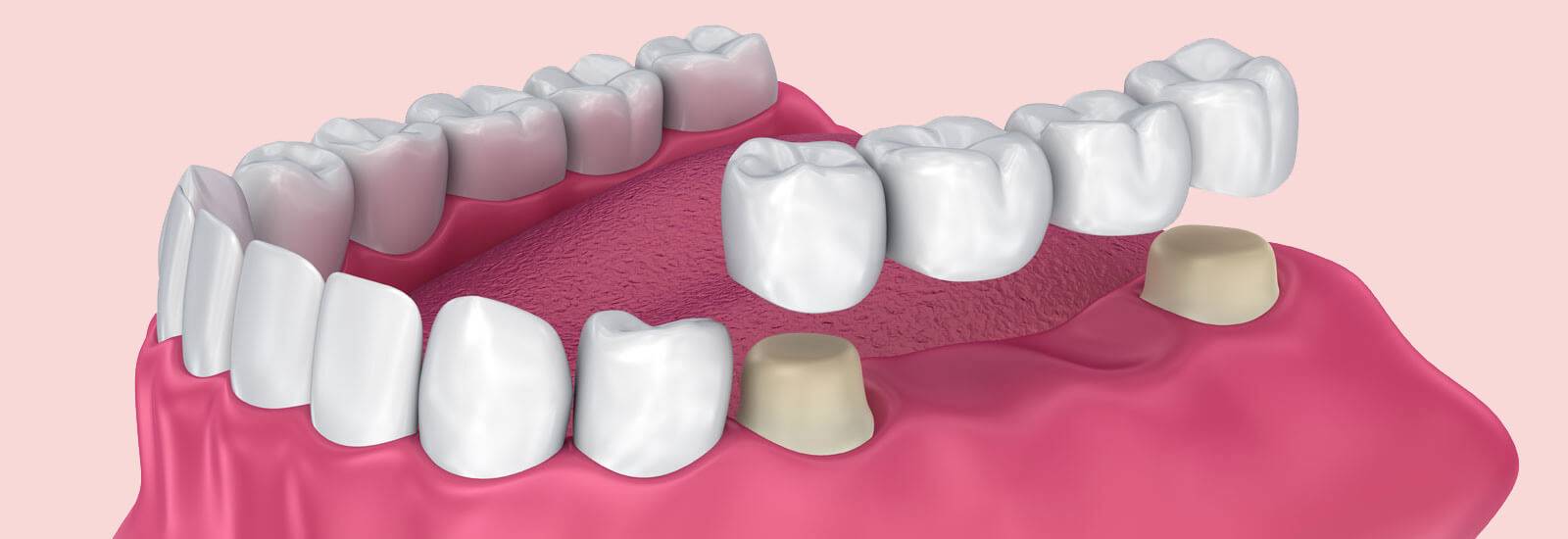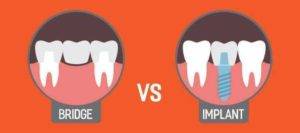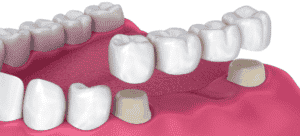Dental Bridges
Dental Bridges also known as the fixed prosthesis are used for replacing one or more teeth. Once fixed, the dental bridges cannot be removed easily. To fix it in a proper position, dental bridges take the support of the artificial teeth and the adjacent teeth. When there are missing teeth, dental bridges help in chewing the food more easily.

Talk to a Dentist Now!
What Are Dental Bridges?
Dental bridges are artificial replacements of missing teeth. They replace one or more teeth that can give an aesthetic appearance to the teeth. They contain three or more units that fill the gap left by a missing tooth. Dental bridges are also called “fixed prostheses”.
They are fixed restorations that contain crowns (also called abutments) that take support from adjacent teeth and artificial teeth(called pontic) to replace the missing teeth. Dental bridges help to chew your food better, This can work even in case of missing teeth.
Dental crowns and bridges are different, As crowns cover just a single tooth, while bridges cover two or more teeth. The dental bridge cost in India depends on several factors. Some of the factors that determine the cost of the dental bridge are types of dental bridges, location, service providers, etc. As per the dentist, you can choose the suitable option for dental bridges.
Since dental bridges are fixed, they cannot be easily removed at home. Dental bridges are extremely routine procedures that are performed by our team at Sabka Dentist clinics. Let’s understand more about them.
Why Should You Get a Dental Bridge?
A large majority of people wonder “Why should I replace a missing tooth?”, especially when they can eat comfortably and are not bothered about the aesthetics due to the missing tooth.
But, did you know, even one missing tooth can disturb the balance in your mouth? Well, it is true! Here’s what happens if you do not replace one or more missing teeth:
- Your bite gets deranged
- Food lodgment occurs in the gap created by the missing tooth
- Alignment problems arise as teeth start moving into the space
- Subsequent chewing problems
- Pain in the jaw due to increased biting force on the teeth
- Speech problems as your tongue comes in contact with your teeth to allow you to speak properly
Apart from these physiologic changes, people who have missing front teeth increasingly become conscious about the gap, which can affect their mental health too.
What Does a Dental Bridge Look Like?

In the mouth, a dental bridge is often unnoticeable when done well. However, every bridge has the following two parts:
- One or more points
- One or more abutments
A pontic is that part of the bridge that replaces the missing tooth/teeth. The abutment is that part of a dental bridge that are crowns placed on the adjacent teeth to anchor or support the dental bridge. For example, to replace one missing tooth, one pontic and two abutments on the adjacent teeth are required. This makes it a 3-unit bridge.
Types of Dental Bridges

Based on the type of connection between the pontic and abutments, dental bridges can be of four types:
- Traditional Bridges – These are the most common types of bridges used to replace missing teeth. In these bridges, there are two or more points that replace the missing teeth, and crowns on two abutment teeth on both sides support the prosthesis and keep the bridge in place. These dental bridges can be made of metal, porcelain fused to metal, or fully ceramic.
- Cantilever Bridges – As the name goes, cantilever dental bridges are similar to cantilever bridges wherein, the bridge is fixed to just one abutment. This bridge is usually recommended when you have teeth only on one side of the gap.
- Maryland Bridges – These bridges are usually found to replace missing front teeth. In this case, the pontic is made from ceramic or metal ceramic and has wings that extend from the bridge onto the abutment teeth.
- Implant-Supported Bridges – These bridges look very similar to traditional bridges with the only difference being that in the case of traditional bridges, the abutments are your natural teeth, whereas in the case of implant-supported bridges, the abutments are implants.
When you visit our dental clinics, our dentists will evaluate the condition of your teeth and suggest the best dental bridge for you.
Benefits of Dental Bridges
There is no doubt that dental bridges have many benefits. These include:
- Restoration of your bite and aesthetics
- Prevent collapsing of bite
- Prevent movement of teeth into the gap of the missing teeth, thereby maintaining teeth alignment
- Prevent speech problems
- Balance the biting forces on your jaw joint, preventing joint troubles
What Does Getting a Dental Bridge Involve?
Now that you know how essential the replacement of missing teeth with dental bridges is, do you know what the process of getting one is?
- Evaluation and clinical assessment: After a complete medical and dental history is taken by your dentist, they will evaluate your teeth, gums, and bone support to determine the best treatment option for you.
- Primary impression: This is the first measurement made of your teeth and gums and used to make study casts.
- Diagnostic wax-up: Your dentist will make wax models of the bridge that he/she wishes to make for you. This will help you visualize how your final bridge is likely to look like.
- Preparation of abutment teeth: Your abutment teeth are those that support your dental bridge. For traditional dental bridges, your dentist determines a path of placement of the bridge and shapes the teeth accordingly to maintain your bite, contact with adjacent and opposing teeth, etc.
- Final impression making: In this next step, your dentist makes the final or master impression of the shaped teeth and adjacent structures, along with the structures in the opposing arch.
This impression is now sent to the lab for the fabrication of your final dental bridge. This step is very important as a poor measurement can affect the fitting of your dental bridge.
- Bite recording: Your dentist will now record your bite, i.e., the way your upper and lower teeth come in contact with each other when static and in various biting movements. This is used while fabricating the dental bridge.
- Fixing of temporary crowns: Until your final dental bridge is fixed, your abutment teeth are covered with temporary crowns.
- Trial of permanent bridge: Your permanent bridge arrives in 2-3 days after the final impression is made and this needs to be tried in your mouth before it can be fixed permanently.
- Final placement of dental bridge: Once your dental bridge is acceptable by your dentist and you, it will be fixed permanently using a strong adhesive cement. Your dental bridge treatment is now complete.
How Do You Maintain Your Dental Bridge?

Once fixed, the dental bridge now becomes a part of your oral cavity and functions just like the other teeth. This also means that you need to take extra care of your bridge, including routine brushing, dental flossing, and visiting your dentist twice a year for teeth cleaning.
Since dental bridges are made from artificial materials, they tend to gather more dirt and deposits as compared to your natural teeth, therefore requiring extra care. Also, to ensure your dental bridge lasts long and in good condition, you may be advised to avoid biting into very hard foods like nuts, popcorn, caramel, etc., using your bridge.
What is the Cost of a Dental Bridge?
Dental bridges are the best and the most affordable way to replace missing teeth. The cost of a dental bridge depends upon various factors such as the type of dental bridge, the number of abutments and politics, and the material chosen. To know more about the cost, head to your closest Sabka Dentist clinic for an evaluation.
With modern dental treatments, materials, and procedures, your missing teeth can be easily and comfortably replaced with dental bridges. Say goodbye to chewing troubles and bad aesthetics due to missing teeth. Visit your nearest Sabka Dentist clinic and walk away with a beautiful smile!
The dental bridge for front teeth can be very effective in restoring the aesthetic nature of the smile. Getting a better dental bridge from reputable dentists can help to improve the aesthetic appearance and improve overall oral health.
Sabka dentist provides quality dental bridge treatment that can restore the aesthetic appearance of the teeth. They have one of the most affordable toothbrick costs in India which can make it easier for any person to get the treatment.
Expert's Opinion
- Dr. Jena Shah Dental Director of Sabka dentist says “Dental bridge is the most reliable option for missing teeth for the ones who cannot get Implants done due to various reasons. It helps is performing the same functions as your natural teeth does.”
- Dr. Ankita Gada Dental Director of Sabka dentist says “Missing teeth can lead to change in facial shape and chewing habits. Dental bridge is the best option to maintain the shape of your face and distribute the forces in your bite properly.”
- Dr. Reena Waghela Dental Director of Sabka dentist says “Dental Bridge is one of the best options used these days to prevent teeth from drifting out of its original position.”
Frequently Asked Questions
What is a 3 unit dental bridge?
A Three Unit Dental Bridge consists of the following components:
- Retainer: A crown i.e. used as part of fixed partial denture for retention and support from abutment tooth is called a Retainer.
- Abutment: It is any tooth, root or implant, which gives attachment and support to fixed partial denture.
- Pontic: Pontic is the artificial tooth that replaces a missing tooth in a fixed partial denture. Pontics are attached to retainers. All the forces acting on the pontic are transferred to abutment through the retainers.
- Connector: It is the connection that exists between
Are dental bridges removable?
No. Dental bridges are fixed partial dentures that are cemented to natural teeth or roots, which furnish the primary support to the prosthesis.
How long after extractions can a bridge be fitted?
Once the socket heals completely after 3 – 6 months following extraction, a bridge can be fitted.
Can a bridge be done on front teeth?
Yes. Bridges can be used as replacement for front teeth. However, there should be adequate support from periodontally sound abutments.
Can a dental bridge replace 2 missing teeth?
Yes. A Dental Bridge can replace 2 or more missing teeth as long as there are sufficient number of abutments to provide support to the prosthesis.
How is a Maryland bridge held in place?
Maryland Bridge is a type of resin bonded fixed partial denture. Mechanical retention in Maryland Bridge is obtained by the micro-porosities present on the tissue surface of retainer, which is created by acid etching.
What is a Pontic tooth?
A Pontic is an artificial tooth on fixed partial denture that replaces missing tooth, restores it’s function and occupies the space previously occupied by natural crown.
Which is better, dental implants or bridging?
A bridge consists of a false tooth suspended between two crowns that are cemented onto prepared natural teeth on either side.
An implant is a false tooth i.e. attached to a titanium post that has been inserted in the jaw bone. The false teeth and crowns in bridges and the false teeth in implants are matched to the color of the surrounding teeth, but, even so, a bridge can be noticed.
Unlike an implant, the false tooth of a bridge isn’t inserted into the jawbone. The location of the missing tooth is important when determining between a bridge or implant replacement.
Time and cost also should be considered. Bridge can be fabricated within few weeks, but the implant procedure may take longer (three to six months). Also, Dental bridges are more affordable over Implants.
How long does a dental bridge last?
With proper oral hygiene and frequent dental visits, a dental bridge can last over 10 years.
What are different types of dental bridges?
- Cantilever Bridges
- Traditional Bridges
- Maryland Bridges
- Implant-Supported Bridges
About Author

Dr.Ankita Gada is a dental director alliances with SabkaDentist. She is a highly skilled dental Surgeon and Implantologist with an experience of more than 10 years. She Pursued her BDS degree from Nair Hospital Dental College, Mumbai, and completed her PGDBA, Marketing from Symbiosis University, Pune.
She is a highly- skilled dentist in implants and planning full mouth rehabilitation cases. She is well versed with all the advanced technology and materials of dentistry that allows her to keep up with the constant changes in the field of modern dentistry.



